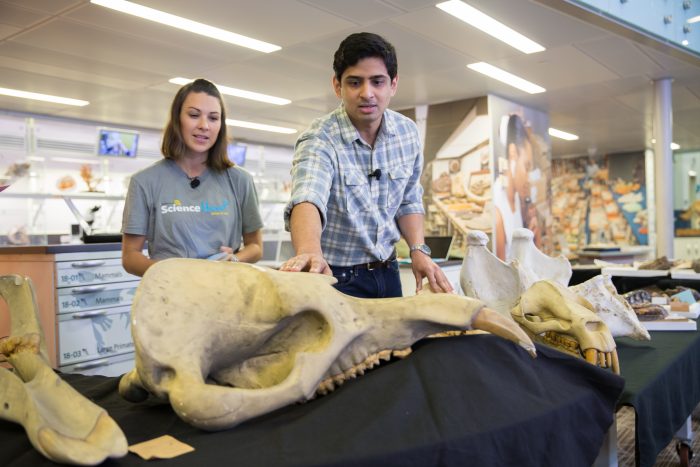Science How, Science Now: Learn from your couch
Looking to continue learning from the Smithsonian while staying at home? Check out the Natural History Museum’s webcast, Smithsonian Science How here – the episodes are especially great if you’ve got school-aged children around. Ralph Nelson is a volunteer with the program.
We all have our reasons for volunteering at the Smithsonian. I love learning something new every day. A year ago I didn’t know a Plesiosaur was not a dinosaur—it’s actually a reptile belonging to the Sauropterygian (reptile flippers) family! I also didn’t know Lichen is the result of algae and fungus being best friends. But that all changed when my volunteer coordinator asked me to do a special project, Smithsonian Science How.

Filming the Smithsonian Science How webcast with co-hosts Maggy Benson and Emmanuel Kyei-Baffour, featuring Paleontologist Karma Nanglu (Photo courtesy Ralph Nelson)
The National Museum of Natural History (NMNH) offers 30-45 minute webcast episodes about science for children ages 8-12, a program called Smithsonian Science How. The episodes are a combination of live interviews with Smithsonian scientists, behind-the-scenes videos, online student polls, and real-time question and answer sessions. That last part is where I come in; I recognize and filter hundreds of students’ questions for the scientists to answer—a pivotal piece of the show. So far, I’ve done eight shows and have incorporated what I’ve learned into my Natural History highlights tours.
Since 2014, Science How has recorded 102 shows, with 52 scientists engaging more than 160,000 students in classrooms across the country. The webcast is made possible by the Smithsonian Youth Access Implementation Grants, a program enabled by the Bill and Melinda Gates Foundation.
The creator and host of the show is Maggy Benson, a staff member at NMNH. When she walks on the set, you can feel the positive energy and know it’s time to tape. She makes you feel that you are about to become part of something bigger than yourself. Oh, she’s smiling too, like all the time.

Filming the Smithsonian Science How webcast with co-hosts Maggy Benson and Emmanuel Kyei-Baffour featuring Paleobiologist Advait Jukar (Photo courtesy Ralph Nelson
I wanted to know what it took to create Smithsonian Science How for Torch. So, I met with Maggy in her office, which was filled with stickies, binders, and stacks of paper. Did you know that students begin to lose interest in the sciences around 6th grade? Maggy says she aims to get them hooked on STEM before that plateau, by sorting, organizing, observing, and making predictions. Focusing on Title I schools, her solution is distance learning for topics from mineral sciences to paleontology. The biggest challenge is finding scientists whose research, discoveries, and challenges dovetail with Next Generation Science Standards. Once found, Maggy makes the information student friendly, packs it into 30 minutes, and makes downloadable pre-show and post-show student handouts.

Set of Science How webcast at the National Museum of Natural History. (Photo courtesy Ralph Nelson)
Is it effective? The feedback is unanimous: teachers and students love it. One teacher recently wrote, “[Smithsonian Science How] was so well delivered and kept my students so interested. I loved the opportunity for them to see a scientist in action and realize that not all scientists are mixing solutions and chemicals….The polls were great and perfectly placed!”
Smithsonian Science How is a magical volunteer experience. Maggy Benson is a singularity and her staff make participating it the process a joy. Best of all, I know when I’m with them, I’ll always be learning something new.
Check out all the available Smithsonian Science How episodes here: https://naturalhistory.si.edu/education/distance-learning/smithsonian-science-how-webcast-archives.
And learn more about NMNH’s distance learning efforts, to be used during the closure or anytime, here: https://naturalhistory.si.edu/education/distance-learning
In addition to watching our archived videos, check out our upcoming LIVE webinars below!
Friday, March 27, 2020
11 a.m. ET
Reading 500-million-year-old Fossils with Paleontologist Karma Nanglu
https://naturalhistory.si.edu/events/video-webinar-reading-500-million-year-old-fossils-paleontologist-karma-nanglu
Thursday, April 2, 2020
2 p.m. ET
How Birds Stay Warm with Ornithologist Sahas Barve
https://naturalhistory.si.edu/events/video-webinar-how-birds-stay-warm-ornithologist-sahas-barve
Ralph G. Nelson is a retired Navy pilot who volunteers as a Smithsonian Science Chat Room Monitor with the Natural History Museum’s Q?rius, the Coralyn W. Whitney Science Education Center. He began volunteering with school programs in 2017, getting teens excited about science. In 2018, Ralph moved to open hours and received the Above and Beyond volunteer of the year award. He started with Science How in 2019, and in 2020 became a Highlights Tour guide.
Posted: 27 March 2020







